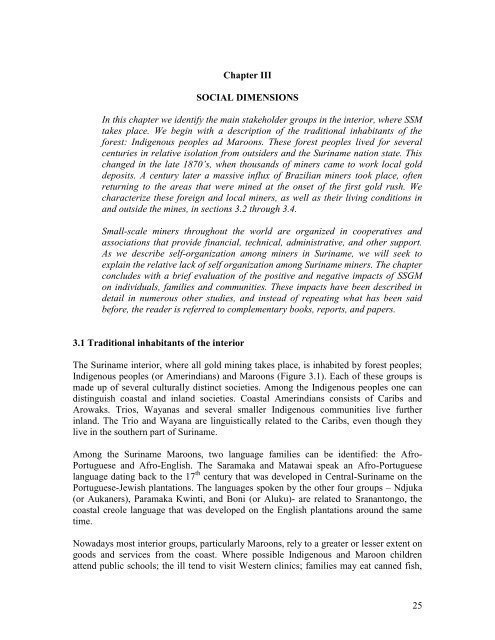SITUATION ANALYSIS OF THE SMALL-SCALE GOLD ... - WWF
SITUATION ANALYSIS OF THE SMALL-SCALE GOLD ... - WWF
SITUATION ANALYSIS OF THE SMALL-SCALE GOLD ... - WWF
Create successful ePaper yourself
Turn your PDF publications into a flip-book with our unique Google optimized e-Paper software.
Chapter III<br />
SOCIAL DIMENSIONS<br />
In this chapter we identify the main stakeholder groups in the interior, where SSM<br />
takes place. We begin with a description of the traditional inhabitants of the<br />
forest: Indigenous peoples ad Maroons. These forest peoples lived for several<br />
centuries in relative isolation from outsiders and the Suriname nation state. This<br />
changed in the late 1870’s, when thousands of miners came to work local gold<br />
deposits. A century later a massive influx of Brazilian miners took place, often<br />
returning to the areas that were mined at the onset of the first gold rush. We<br />
characterize these foreign and local miners, as well as their living conditions in<br />
and outside the mines, in sections 3.2 through 3.4.<br />
Small-scale miners throughout the world are organized in cooperatives and<br />
associations that provide financial, technical, administrative, and other support.<br />
As we describe self-organization among miners in Suriname, we will seek to<br />
explain the relative lack of self organization among Suriname miners. The chapter<br />
concludes with a brief evaluation of the positive and negative impacts of SSGM<br />
on individuals, families and communities. These impacts have been described in<br />
detail in numerous other studies, and instead of repeating what has been said<br />
before, the reader is referred to complementary books, reports, and papers.<br />
3.1 Traditional inhabitants of the interior<br />
The Suriname interior, where all gold mining takes place, is inhabited by forest peoples;<br />
Indigenous peoples (or Amerindians) and Maroons (Figure 3.1). Each of these groups is<br />
made up of several culturally distinct societies. Among the Indigenous peoples one can<br />
distinguish coastal and inland societies. Coastal Amerindians consists of Caribs and<br />
Arowaks. Trios, Wayanas and several smaller Indigenous communities live further<br />
inland. The Trio and Wayana are linguistically related to the Caribs, even though they<br />
live in the southern part of Suriname.<br />
Among the Suriname Maroons, two language families can be identified: the Afro-<br />
Portuguese and Afro-English. The Saramaka and Matawai speak an Afro-Portuguese<br />
language dating back to the 17 th century that was developed in Central-Suriname on the<br />
Portuguese-Jewish plantations. The languages spoken by the other four groups – Ndjuka<br />
(or Aukaners), Paramaka Kwinti, and Boni (or Aluku)- are related to Sranantongo, the<br />
coastal creole language that was developed on the English plantations around the same<br />
time.<br />
Nowadays most interior groups, particularly Maroons, rely to a greater or lesser extent on<br />
goods and services from the coast. Where possible Indigenous and Maroon children<br />
attend public schools; the ill tend to visit Western clinics; families may eat canned fish,<br />
25
















